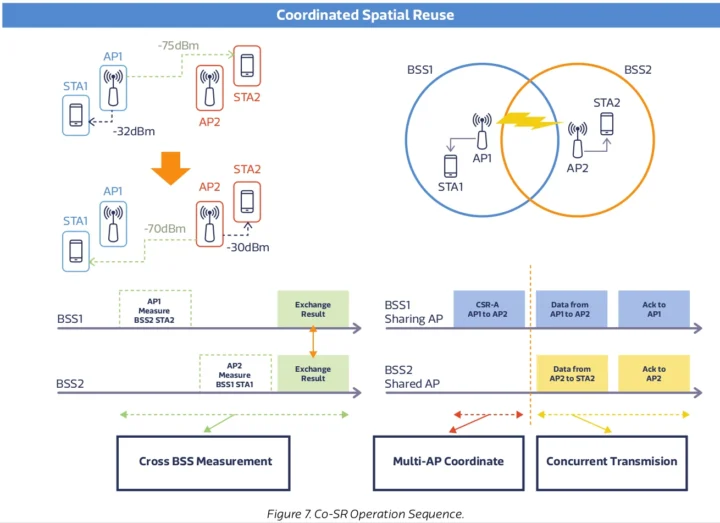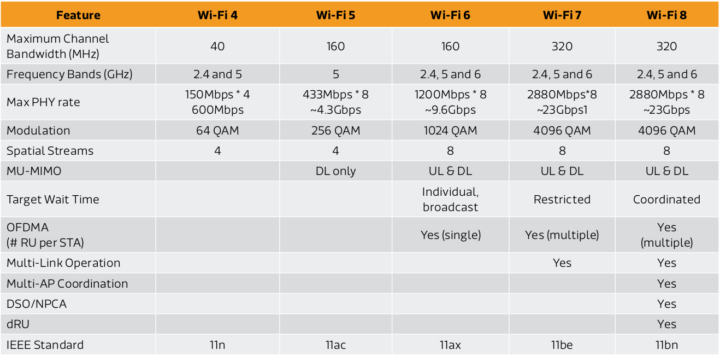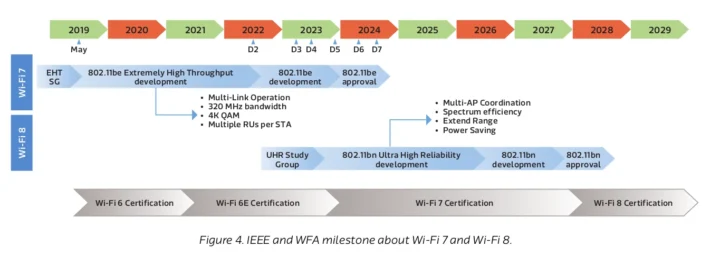Wi-Fi 7 (802.11be) routers and modules have only been launched recently, but engineers are already working on Wi-Fi 8 (802.11bn) “Ultra High Reliability (UHR)”, and MediaTek shared some details in a whitepaper detailing some of the improvements of the new standard for its upcoming Filogic Wi-Fi 8 SoCs.
Surprisingly, there aren’t any enhancements to the maximum performance with Wi-Fi 8 still offering up to 320 MHz channel bandwidth, 23 Gbps maximum PHY rate, and support for 2.4 GHz, 5GHz, and 6GHz frequency bands, as well as up to 8 spatial streams. The Wi-Fi 8 improvements are all meant to improve Wi-Fi reliability, network efficiency, and power consumption in IoT use cases, which will end up improving the overall WLAN performance when many nodes are connected.
Wi-Fi 8 new features:
- Coordinated Target Wait Time (TWT) allows low-power IoT devices to negotiate specific times for transmission with access points in order to lower power consumption and decrease the likelihood of contention with non-latency-sensitive traffic.
- Multi-AP Coordination – With the popularity of mesh networking, many WiFi installations now include several access points. This requires effective coordination, or these APs may contend and share the common spectrum resources, resulting in often only one AP utilizing the spectrum at any given time. WiFi 8’s Multi-AP coordination aims to optimize the sharing of resources between multiple access points. Some techniques used are explained in detail in MediaTek’s whitepaper
- Coordinated Spatial Reuse (Co-SR) adjusts the TX power to clients (up or down) when there are multiple APs to optimize the overall network performance. MediaTek reports 15% to 25% improvement in overall throughput.
- Coordinated Beamforming (Co-BF) is used when APs are closed to each other and Co-SR cannot work properly, and beamforming is optimized to lower interference as opposed to Tx power. MediaTek reports 20% to 50% overall throughput improvement in a mesh network setup. It works especially well in densely populated urban areas or large retail spaces.
- DSO (Dynamic Spectrum Optimization) and NPCA (Non-Primary Channel Access) are designed to optimize performance when there is a disparity in the number of streams and channel
bandwidths among devices. DSO optimizes the bandwidth when the AP and client have different channel bandwidths, for example, 320 MHz for a router and 80 MHz for a smartphone, and also DSO dynamically adjusts channel assignments to optimize performance. NPCA aims to resolve scenarios where the primary channel is unavailable, allowing communication between the AP and the client to occur via a non-primary channel. - dRU (Distributed Resource Units) is designed for low-power indoor (LPI) devices in the 6 GHz band and allows for the distribution of allocated tones across a wider bandwidth, reducing the number of tones per MHz. This results in higher uplink OFDMA transmission power for this type of device. Note: this is not explained in MediaTek’s whitepaper, but I found details in a guest article on Wi-Fi Now instead.
- Millimeter Wave (IIMMW) and AI/ML services – We don’t have many details about this right now, but the white paper mentions those as Wi-Fi services that fall outside the scope of the 802.11bn standard. We’ll probably get more details once the IEEE 802.11bn standard is closer to ratification.

I’m sure we’ll learn more about Wi-Fi 8 as time passes. This whitepaper is dubbed “Part one: Fast efficient spectrum”, so we may expect more from MediaTek, and the Wi-Fi 7 and Wi-Fi 8 timelines show we have plenty of time since 802.11bn approval is only scheduled for 2028. We may see the first implementations as early as 2026 or 2027 as some companies will likely introduce Wi-Fi 8 SoCs and hardware based on the draft specifications, as some did with WiFi 7, for example, MaxLinear MxL31712 / MxL31708 and Qualcomm Networking Pro Series Gen 3 both introduced in 2022 among others.

Jean-Luc started CNX Software in 2010 as a part-time endeavor, before quitting his job as a software engineering manager, and starting to write daily news, and reviews full time later in 2011.
Support CNX Software! Donate via cryptocurrencies, become a Patron on Patreon, or purchase goods on Amazon or Aliexpress






